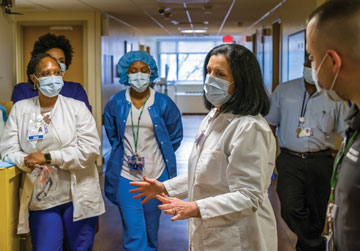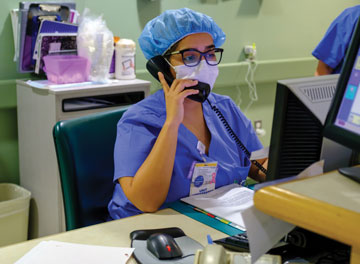At the time of this issue’s publication, the U.S. Department of Health and Human Services (HHS) had extended the federal COVID-19 public health emergency (PHE) declaration, which was set to expire this month. The PHE declaration provides
state governments and healthcare facilities with additional funding and resources to care for COVID-19 patients and prevent the spread of the coronavirus.
So is COVID-19 coming to an end? How much longer will we need to live and work in a pandemic state? Richard Martinello, MD, an associate professor of infectious diseases and medical director of infection prevention at Yale School of Medicine
in New Haven, Conn., says declaring that COVID-19 is endemic a complex issue. “The clinical reality is that we will go from dealing with unpredictable waves of infections to settling into some sort of seasonal pattern,” says
Dr. Martinello. “I expect it will take two to three years until we understand that pattern, which will be determined by the degree of immunity within regional populations and how the virus behaves in warm and cold weather.”
He believes there’s an underlying assumption COVID-19 will blend into the background — we’ll learn to live with the nuisance of relatively minor infections — but no one is certain that will be the case. Although COVID-19
will likely develop an endemic pattern, Dr. Martinello cautions it could turn out to be much worse than the seasonal flu. “Declaring the start of the endemic and thinking we need to get back to normal life is a naive point of view,”
he says. “We all want the pandemic to be over, but the reality is there’s still a great deal of uncertainty about what the future holds.”
If nothing else, surgical professionals have proven how resourceful and resilient they can be when challenged with the unknown. The nimbleness they’ve shown and the lessons they’ve learned over the past two years will help them
navigate the end of the pandemic, whenever it arrives, and prepare them to face whatever comes next.
The healthcare supply chain is dealing with numerous challenges, according to Phyllis McCready, senior vice president
and chief procurement officer at Northwell Health in New Hyde Park, N.Y. At the height of the pandemic, Northwell’s surgical departments were well-stocked, so her focus shifted to managing supplies needed to treat COVID-19 patients
and protect staff. “We had an ample supply to support our patients and clinical teams,” says Ms. McCready. “We planned well in advance with N95 masks and had small amounts of inventory coming in from the manufacturers.
Isolation gowns were our number one item during the beginning of the crisis. They were being used at an unbelievable rate. We had a significant inventory and almost ran out.”
As a large healthcare system, Northwell enjoys certain advantages that smaller and independent ASCs do not. In addition to an ability to leverage favorable deals with suppliers due to its size, Northwell also manages an 86,000-square-foot
distribution center that houses more than 3,000 items, mostly disposable products used within Northwell’s labs, ORs and med-surg units. The distribution center maintains inventory to support supply needs at Northwell’s hospitals
and surgery centers. “We’ve never been just-in-time from supply manufacturers,” says Ms. McCready.
Diversifying suppliers was a beneficial strategy during the pandemic and will continue to be. “I have multiple suppliers for products that I know are critical to patient care,” says Ms. McCready. “This enables flexibility,
which in turn allows us to respond to changing market trends and customer demands.”
The dynamic of negotiating contracts to ensure supply continuity for surgery centers has permanently changed, according to Julie Sebree, vice president of procurement and supply chain for Envision Healthcare, a national medical group representing
more than 250 ASCs. Relationships with national, regional and local distribution partners are also under strain.
“We can’t rely solely on our partners to get us what is needed, so we created a centralized purchasing and distribution model for critical products — mostly PPE such as masks, gowns and gloves,” says Ms. Sebree. “We
sourced those products directly from manufacturers, stored them in a central warehouse and had them available any time one of our ASCs was unable to get orders filled through their national or regional distribution partners. They had a
place internally to get products that were approved, vetted and available to them, so they never had to do without.”
Ms. Sebree says the current supply chain situation is not so much about shortages but what she calls continuing tightness based on shifts in supply and demand. For example, the big issue currently is glove availability. “There has not
been any significant investment in glove production since the beginning of the pandemic, but a drastic increase in demand,” she says. “That tightness is going to continue until there’s some investment in additional
production.”
Ms. Sebree says the past two years have altered her interactions with vendors and distributors. “The conversations before the pandemic were very transactional to make the purchase,” she says. “The conversations now are much
more collaborative and strategic. We talk about forecasting, where we would like to see investment in manufacturing or in their supply chain. We’re asking more questions so we can be proactive and look for diversification in manufacturers,
in the geography of manufacturers or in products, so we’re better prepared should we need to pivot again in the future.”
.svg?sfvrsn=be606e78_3)


.svg?sfvrsn=56b2f850_5)